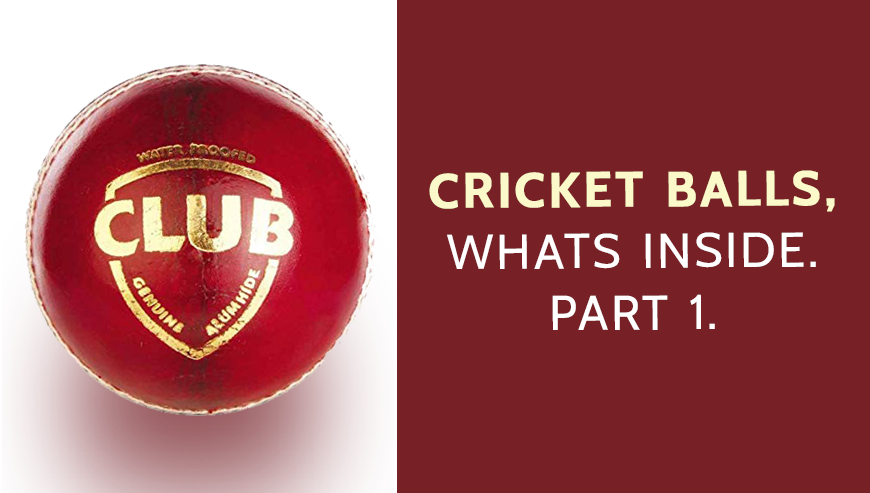Cricket balls, whats really inside and what drives the price?
I often get asked about cricket balls. Whats the best? Whats the cheapest? Why and which cricket balls break cricket bats? etc etc etc and many times ive been unable to answer people simply because of a lack of knowledge. So i decided to do a bit of exploring to see what i could find out. I looked on youtube. That was a waste of time. It had very little information on how cricket balls are essentially put together. I checked on Wikipedia for the ICC regulations of how cricket balls should be made and also came up empty handed. So eventually i just decided that seen as its so hard to figure out whats inside a cricket ball and how they are made i will just cut a couple of them open and see for myself.
Here is what a good cricket ball looks like on the inside.

Youtube will have many many videos showing cricket balls being made but i couldnt find any detail to show exactly what goes into all the different layers of cricket balls. That may be partly because some of the cricket balls i cut open only had 3 layers to them. ( rubber, string and leather ) but many people will agree that the Kookaburra Turf cricket ball may well be the Benchmark all other cricket balls are modelled after. The Kookaburra Turf ball is used by 85% of all international test matches worldwide so that speaks volumes for the quality and reputation of the cricket ball.
The kookaburra Turf cricket ball has a small ( slightly smaller than a golf ball cork / rubber core. Then has 5 layers of cork / string quilted.The leather is not just any old leather. Its Hand selected Australian first grade alum tanned steer hide and is tough as nails.
The problem with this ball is it retails for well over $100 USD and lets be honest, none of us can afford to throw around 5 or 10 of these at our local club practices. So what i will be trying to do in the blog is not to say which cricket balls are the best, but rather educate the everyday club cricketer so they can better understand whats happening on the inside of a cricket ball and perhaps also understand why so many modern balls are classified as bat breakers or perhaps lose shape, shine or hardness to quickly.
Enjoy.
WHITE CRICKET BALLS with large core.

This ball has a surprising black core. which means its mostly black rubber with a very small amount of cork mixed into it. My thought is that if this ball loses shape or breaks easily that this is partially the reason. This is about the polar opposite of the mega high end kookaburra turf ball.Outside of the large black core is 1 layer of cork with what i would say is a medium amount of good quality string. This CA attack cricket ball had 61 stitches.
CA League special cricket ball.

This CA league special ball has once again got a large black majority rubber core even though its slightly smaller than the CA attack ball.This ball has 2 layers of cork and string around the rubber core hence explaining why the price has gone up $4 up to $10 for this ball. This ball should therefore provide slightly more even bounce and stability but due to the large black rubber core will still be prone to losing shape / deforming and issues like taking on water etc. I found that the protective coating on this ball that protects the leather was prone to cracking. This CA league special had 66 stitches.

The CA super test cricket ball is now looking much more like a proper cricket ball and i would say this is the kind of ball clubs should be looking to use for cricket matches. This cricket ball looks to have a good 50/50 cork & rubber core nucleas. Then has 5 layers of cork surrounded by a very good amount of high quality string. For all intensive purposes this looks to be a good quality ball with a decent quality leather. The leathers seems good and flexible but still the protective coating seems to be prone to cracking and peeling. A low quality protecting spray would crack and peel off leaving the leather prone to absorbing water etc. I still think from what weve seen so far that this is a good quality cricket ball and club cricketers around the country would do well to get their hands on a couple of these for nets and matches. This CA super test cricket ball had 70 stitches.

So dropping down in price slightly again from $16 down to $13, the CA test star drops in price as it drops in quality slightly. Here once again we see the slightly larger cork / rubber core of the cricket ball. It then has 2 layers of cork with only a medium amount of a 2 strand string to help keep everything in place. This CA test star cricket ball had 65 stitches.
Slazenger ultimate white cricket ball

This is a high end offering from Slazenger cricket. I like the touch of them using the black string and stitching. We see slazenger have a high quality build here in the ball make up. It has a high quality cork / rubber small core with 5 layer cork and multi thread string. One thing i noticed different in this ball was that most other balls have a plastic layer which cover the internal parts of the ball and is under the leather. This ball however has a wood / cardboard based material which i feel if it happened to get wet would not hold the shape of the ball very well. Whilst trying to tear the plastic from other balls it was almost impossible but was quite easy to tear this using just my hands. I am no cricket ball expert but see with even Gray Nicolls that they use a plastic layer and so this is something to think about when purchasing your new Slazenger ultimate cricket balls. The clear coating on this ball which protects the leather seemed flexible though and was not prone to cracking or peeling. This slazenger ultimate cricket ball had 70 stitches.

The SG test ball is one of the high end SG ball offerings at $27. In taking this ball apart i found the leather to be very very hard and not flexible at all.We have a good amount of high quality string surrounding the 5 cork layers but the core seems to be blacker than the other balls so meaning a higher concentration of rubber rather than cork. I found it interesting that these balls are advertised as haveing been water proofed. That could be some sort of coating or a treatment to the leather and that could explain why the leather seems to be harder than the other balls tested so far. The plastic inner cap in this case seems to be non existant once again and in this balls case it seems to have been replaced with some very thin leather quarters. I fear this ball may lose shape quit easily if the " water proofing " fails and water gets into the ball. This ball doesnt seem to have been sprayed with any sort of coating. I guess thats because the leather has been treated with the " water proofing". This SG Test ball had 64 stitches.

This is a middle of the road $14 SG club cricket ball. At first glance this ball looks well put together but once you have a close look it gets interesting. The core has shiny silver " tin foil " like flakes inbedded in the cork. im not sure exactly what that is and what purpose it has. The 5 cork layers were also strange. The cork was extremely brittle and broke up very easily when trying to separate them. The cork almost looked like dried paste.The string was very dirty. The plastic cap was very thin and came out very easily. The only thing that looked decent on this ball was the leather. i dont want to say anything but its almost like the put a nice dress on an ugly wench. wink wink..This SG club ball had 68 stitches.

This is the Graddige club cricket ball. Imported from pakistan and selling at around the $10 mark. We can see here a large cork and rubber core with just about no string at all. It does have the inner plastic cap to help keep the balls shape and then a decent quality supple leather. The protective coating on the leather seemed durable and didnt crack or peel.The stitch count on this graddige club ball was 70.
Thats it for this part 1 of this look at some common cricket balls we find here in the American market. Look out for parts 2, 3 and 4 coming over the next couple days..If you have questions or queries please feel free to email support@cricketstoreonline.zendesk.com:


